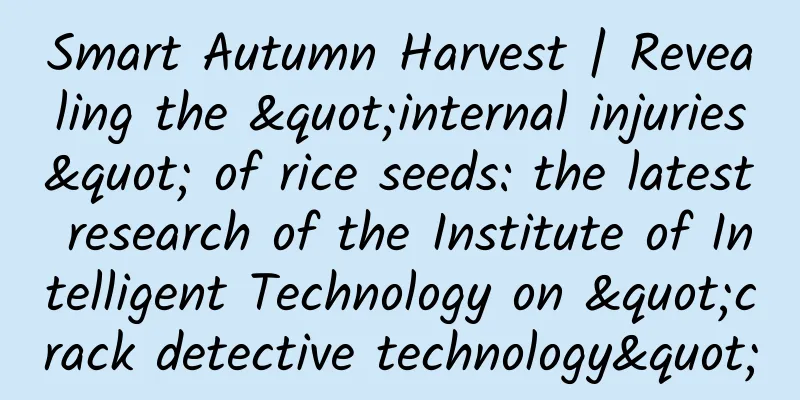Smart Autumn Harvest | Revealing the "internal injuries" of rice seeds: the latest research of the Institute of Intelligent Technology on "crack detective technology"

|
Produced by: Science Popularization China Author: Wang Liusan (Institute of Intelligent Machinery, Hefei Institutes of Physical Science, Chinese Academy of Sciences) Producer: China Science Expo Editor's note: To showcase the latest trends in intelligent technology, the China Science Popularization Frontier Technology Project has launched a series of articles on "Artificial Intelligence" to provide a glimpse into the latest progress in artificial intelligence and respond to various concerns and curiosities. Let us explore together and welcome the intelligent era. AI Farmer Assistant Business Card Assistant: Nondestructive detection of internal cracks in rice seeds using near-infrared spectroscopy Two magic weapons: non-destructive testing and artificial intelligence Two key technologies: near-infrared spectroscopy transmission technology and machine learning algorithm Energy value: 5 stars ID photo: FT-NIR Spectrometer (Image source: provided by the author) Smart Autumn Harvest Assistant Self-Introduction Nice to meet you, I am a member of the Institute of Intelligent Machinery, Hefei Institutes of Physical Science, Chinese Academy of Sciences. Near infrared spectroscopy seed internal crack detection technology can quickly and accurately detect seed internal cracks without destroying rice seeds. Differentiate rice seeds Rice is an important crop in the world, with a harvest area of 167 million hectares and a total output of 769 million tons in 2017, providing basic food for nearly half of the world's population. In order to meet the growing demand for rice production, people need high-quality seeds. Rice (Photo source: veer photo gallery) However, rice seeds are prone to internal cracks during artificial drying or sun drying before harvest, and are also susceptible to mechanical damage during harvesting, transportation, storage and handling. Internal cracks in rice seeds affect seed germination quality and emergence rate, and internal cracks are difficult to detect with the human eye. Therefore, a method is urgently needed to distinguish rice seeds with internal cracks from normal seeds before sowing. The traditional method for identifying rice seeds with internal cracks is visual inspection. It is destructive, subjective, and time-consuming, and is not suitable for testing a large number of samples. Therefore, it is necessary to propose a non-destructive and rapid method to identify rice seeds with internal cracks. Recently, X-ray imaging has been used to detect internal cracks in rice grains and bean seeds. However, X-rays are radioactive and costly, and are not easy to popularize. In contrast, my birth provides a rapid, non-destructive, and inexpensive analysis method. Crack seeds (Image source: provided by the author) Near infrared spectroscopy The near-infrared spectrum I emit is an electromagnetic wave between visible light and mid-infrared. The American Society for Materials Testing defines the near-infrared spectral region as 780-2526 nm. The near-infrared spectral region is consistent with the absorption region of the combined frequency and various harmonic frequencies of the vibration of hydrogen-containing groups (OH, NH, CH) in organic molecules. By scanning the near-infrared spectrum of the sample, the characteristic information of the hydrogen-containing groups in the organic molecules in the sample can be obtained. In addition, using me to analyze samples has the advantages of being convenient, fast, efficient, accurate and low-cost, without destroying the sample, consuming chemical reagents, or polluting the environment. It has been widely used in industry, agriculture, medicine, food and other fields. How to detect? The researchers purchased two hybrid rice seeds (Liangyou 566 and Y Liangyou 1982, both of which are indica two-line hybrid rice varieties) from the local seed market. 99 (Liangyou 566) and 40 (Y Liangyou 1982) internal cracked rice seeds were selected by professional technicians using a homemade light box measuring instrument. In addition, 100 normal (Liangyou 566) and 40 (Y Liangyou 1982) rice seeds were selected, making up 279 rice seed samples. In the second step, the researchers used me to obtain the transmission spectrum of rice seeds. The rice seeds were placed on a sample stage, covered with a lid with a collection detector, and illuminated with a halogen lamp. The light was transmitted through the rice seeds to the detector, and the transmission spectrum of each rice seed was collected. Before measuring the spectrum, the rice seeds were covered with a lid to avoid interference from the ambient light around the seeds. Halogen bulbs (Photo source: veer photo gallery) The changes in the measurement state of rice seeds and the working state of the spectrometer may cause random noise, baseline drift and multiple scattering. In order to reduce the impact of these effects on the robustness of the model and improve the prediction accuracy of the model, the spectral data needs to be preprocessed. Several spectral preprocessing methods were compared in the study, including no preprocessing (raw spectrum), standard normal variate (SNV), multiple scatter correction (MSC), and first and second derivatives of Savitzky-Golay smoothing. The standard normal variate transformation is to subtract the ideal spectrum from the original spectrum of each sample and then divide it by the standard deviation. The ideal spectrum is usually the average spectrum of each sample. Multivariate scatter correction is to add the measured spectrum to a reference spectrum to reduce these unrelated changes. The reference spectrum is usually the average spectrum of all measured spectra. Both methods can be used to eliminate scattering errors. The first and second derivatives of Savitzky-Golay smoothing are mainly used to reduce noise, eliminate baseline drift and improve spectral resolution. Principal component analysis (PCA) is a classic data analysis method that reveals data patterns and internal structures by reducing data dimensionality. Usually, the first few principal components (PCs) can maximize the spectral variation of a dataset and explain sample grouping and similarity. We performed an exploratory analysis of raw rice seed spectra using PCA. The original and processed spectral data were used to establish a rice seed internal crack recognition model through four machine learning algorithms commonly used in artificial intelligence (PLS-DA, SVM, KNN and RF). 75% of all samples (210 rice seeds) were used to build the model, and the remaining samples were used to test the model. The results show that PLS-DA combined with raw spectral data has the best model performance. SVM has a poor performance, but is better than RF and KNN. In addition to PLS-DA, the four different preprocessing methods all improve the performance of the developed model. Wavelength importance analysis showed that the important variable for identifying internal cracks in rice seeds was related to the amylose content. Therefore, it can be concluded that I can be used as a rapid and non-destructive method to identify internal cracks in rice seeds. Variable Importance in Prediction (VIP) Scores in PLS-DA Analysis (Image source: provided by the author) Message from the Assistant With the development of machine learning algorithms, I can combine machine learning algorithms for broader applications. In order to obtain more robust near-infrared spectroscopy models, researchers need more rice samples of different varieties, which promotes my practical application in rice internal crack detection. My application not only improves the efficiency and accuracy of rice seed quality evaluation, but also provides a new technical means for seed quality control in agricultural production. |
<<: If you keep getting acne, it may be caused by this! Dermatologists remind you...
>>: After making groundbreaking contributions, she was "rescued" by the 2024 Lasker Award
Recommend
WeChat group money-making project, one order earns hundreds to thousands, monthly income exceeds 100,000+
Qingmu WeChat group money-making project, one ord...
Understand at a glance: The correct way to use express delivery and takeout during the epidemic!
Recently, with the spread of the epidemic and the...
When optimizing to scale to multiple cores…
When optimizing to scale to multiple cores "...
On Humanity’s Lunar Day, how to protect the lunar heritage?
In order to take a photo of the banner on the lun...
Chumei, the "best plum blossom in the world": 2,500 years old and still as fragrant as ever
Two days ago, I heard that the Chu plum blossoms ...
Can product managers help traditional TV terminals trigger a wave of home entertainment?
On the road of Internet development, product mana...
Analysis of 11 cases and 4 logical points of growth hacking!
The 4 key points of growth hacking: Providing hig...
The BUG in Marketing to Generation Z
Today, the main force of China's consumption ...
Does Xiaomi really want to make its own processors like Huawei?
It is not a new concept for mobile phone brands t...
Songyuan SEO training: How to distinguish between SEO and Baidu promotion? Which one is suitable for you?
With the development of Internet technology, comp...
How to make copywriting come alive? Learn these 4 tips
Copywriters need to constantly accumulate new wor...
Butterknife full analysis
Overview Butterknife is an open source library de...
The effects of Guangdiantong and WeChat Moments are not good? Key points for account operation!
There are countless channels for information flow...
Why do I say that most people who follow hot topics are unreliable?
Talking about hot topics and leveraging trends, i...
It’s time to spend the money! Local cultural tourism gave specialties to Erbin, and so many "hidden items" were discovered!
Editor: Sunny Morning Not long ago, after Guangxi...




![51st episode of the online special warfare class of Qiaojiang Taobao artist recorded video tutorial [Clown]](/upload/images/67cc2c8304bd7.webp)




